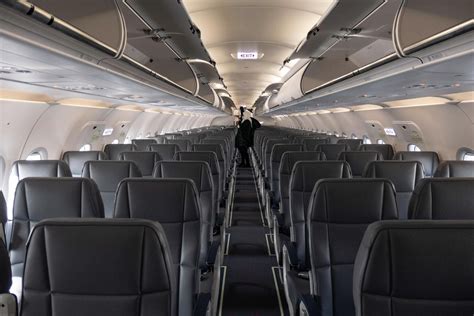
A risky new travel trend involving joining flights solely for the perceived social media clout is being heavily criticized as irresponsible, environmentally damaging, and potentially dangerous, as individuals prioritize fleeting internet fame over personal safety, financial prudence, and ecological responsibility.
Social media platforms are currently awash with videos and posts showcasing individuals embarking on what has been dubbed the “single-flight” trend – purchasing a plane ticket with the explicit intention of experiencing the flight itself, without any regard for the destination. These individuals often document their journeys, highlighting the in-flight experience, the airport ambiance, and, most concerningly, the supposed thrill of flouting conventional travel norms. Travel experts and environmental advocates are warning against the perils of this trend, cautioning that it not only promotes unsustainable travel practices but also poses significant financial and safety risks for those involved.
“It’s really baffling to see people spending money on flights they don’t need to take, just for the sake of a social media post,” said Emily Carter, a seasoned travel consultant with over a decade of experience in the industry. “This trend completely disregards the environmental impact of flying and encourages frivolous spending.”
The allure of this trend lies in its perceived novelty and the potential for viral content creation. Participants often film themselves at the airport, during the flight, and even upon arrival, highlighting their experiences with hashtags like #SingleFlightChallenge, #PointlessTravel, and #MileHighClub… of points. The videos often garner significant attention, with some racking up hundreds of thousands, and sometimes millions of views, thus incentivizing more individuals to participate in this questionable activity.
However, the reality of this trend is far from glamorous. Beyond the superficial appeal of social media recognition, there are several significant downsides to consider.
Environmental Impact
The most glaring concern associated with the single-flight trend is its detrimental impact on the environment. Air travel is a significant contributor to greenhouse gas emissions, and unnecessary flights exacerbate the problem. According to the Environmental Protection Agency (EPA), aircraft emissions account for approximately 11% of the U.S. transportation sector’s greenhouse gas emissions, and 3% of total U.S. greenhouse gas emissions.
Each flight, regardless of its purpose, releases tons of carbon dioxide and other harmful pollutants into the atmosphere. Experts say that an average round-trip flight between New York and London can generate nearly one ton of carbon dioxide per passenger, which is equivalent to the emissions produced by driving a typical passenger vehicle for approximately six months. The single-flight trend, therefore, contributes to the worsening of climate change and its associated consequences, such as rising sea levels, extreme weather events, and disruptions to ecosystems.
“It’s irresponsible to ignore the environmental consequences of unnecessary air travel,” says Dr. David Miller, an environmental scientist specializing in carbon footprint analysis. “Every flight contributes to the problem, and encouraging people to fly just for the sake of a trend is simply unacceptable.”
Moreover, the carbon offset programs often touted by airlines as a means of mitigating the environmental impact of flying are not always effective or reliable. Many carbon offset projects lack transparency and accountability, and some have even been accused of greenwashing, where companies make misleading claims about their environmental performance.
Financial Implications
Participating in the single-flight trend can also have significant financial implications. Airline tickets, especially for long-haul flights, can be expensive, and the cost of transportation to and from the airport, meals, and other expenses can quickly add up.
“People are essentially throwing money away on something that offers no real value,” Carter explains. “That money could be better spent on experiences that are more meaningful and sustainable, like local travel or investing in education.”
Furthermore, there is no guarantee that the social media content generated from these flights will be successful. While some participants may achieve viral fame, many others will find that their videos and posts receive little attention, leaving them with nothing but a hefty credit card bill and a sense of disappointment. The quest for social media validation, in this context, becomes a financially risky gamble with potentially little return.
Safety Concerns
While the safety risks associated with the single-flight trend may not be immediately obvious, they are nonetheless significant. Air travel involves inherent risks, and any unforeseen circumstances, such as mechanical issues, turbulence, or medical emergencies, can pose a threat to passengers.
By embarking on flights with no real purpose, individuals are exposing themselves to these risks unnecessarily. Moreover, the focus on capturing social media content can distract passengers from paying attention to safety briefings and following crew instructions. This can be particularly dangerous in the event of an emergency, where quick thinking and adherence to safety protocols are crucial.
Additionally, the single-flight trend can lead to overcrowding on flights, increasing the risk of transmission of infectious diseases. In the wake of the COVID-19 pandemic, health experts have emphasized the importance of minimizing unnecessary travel and taking precautions to prevent the spread of respiratory illnesses.
Ethical Considerations
Beyond the environmental, financial, and safety concerns, the single-flight trend also raises ethical questions about responsible travel and social media influence. By promoting unnecessary air travel, participants are contributing to a culture of consumerism and instant gratification, where experiences are valued primarily for their potential to generate online attention.
“It’s important to consider the ethical implications of our actions, both online and offline,” says Dr. Sarah Jones, a professor of media ethics. “The single-flight trend promotes a shallow and unsustainable approach to travel, where the focus is on personal gain rather than contributing to the well-being of the planet and its communities.”
Social media influencers, in particular, have a responsibility to use their platforms to promote positive and responsible behavior. By endorsing the single-flight trend, they are setting a bad example for their followers and undermining efforts to promote sustainable travel practices.
Alternative Travel Options
Instead of engaging in the single-flight trend, individuals can explore alternative travel options that are both more environmentally friendly and financially responsible.
- Local Travel: Exploring one’s own city or region can be a rewarding and sustainable way to travel. Local travel reduces the need for long-distance transportation, minimizing the environmental impact.
- Train Travel: Train travel is a more environmentally friendly alternative to air travel, especially for shorter distances. Trains are also often more comfortable and offer scenic views.
- Road Trips: Road trips can be a fun and flexible way to travel, allowing you to explore different destinations at your own pace. Consider renting a fuel-efficient vehicle or using public transportation for part of the journey.
- Virtual Travel: With advancements in technology, virtual travel experiences are becoming increasingly immersive and engaging. Virtual tours, simulations, and online events can provide a taste of different cultures and destinations without the need to physically travel.
The Need for Responsible Social Media Use
The single-flight trend highlights the need for more responsible social media use. Individuals should be mindful of the potential consequences of their online actions and avoid promoting behaviors that are harmful to the environment, financially irresponsible, or pose safety risks.
Social media platforms also have a responsibility to address the spread of misinformation and harmful content. They should implement policies and algorithms that discourage the promotion of unsustainable travel trends and promote responsible travel practices.
Ultimately, the single-flight trend serves as a cautionary tale about the dangers of prioritizing social media validation over real-world consequences. By making informed choices and embracing sustainable travel practices, individuals can enjoy the benefits of travel without contributing to environmental degradation or endangering their own well-being.
Expert Opinions and Data
Several experts have weighed in on the single-flight trend, highlighting its various drawbacks and offering alternative perspectives.
- Environmental Impact: A study by the International Council on Clean Transportation (ICCT) found that aviation emissions are growing faster than any other transportation sector. The study emphasized the need for urgent action to reduce aviation’s carbon footprint, including measures such as fuel efficiency improvements, alternative fuels, and carbon pricing.
- Financial Implications: According to a survey by Bankrate, the average cost of a domestic round-trip flight in the United States is approximately $350. This figure can vary depending on factors such as the destination, time of year, and booking date.
- Safety Concerns: The National Transportation Safety Board (NTSB) investigates all civil aviation accidents in the United States. The NTSB’s investigations often reveal safety deficiencies that can contribute to accidents, such as inadequate maintenance, pilot error, or air traffic control issues.
The Broader Context of Travel Trends
The single-flight trend is just one example of a broader range of travel trends that are being driven by social media. Other trends include:
- Revenge Travel: This trend refers to the surge in travel demand following the easing of COVID-19 restrictions, as people seek to make up for lost time and experiences.
- Sustainable Travel: This trend emphasizes the importance of minimizing the environmental and social impact of travel. Sustainable travel practices include choosing eco-friendly accommodations, supporting local businesses, and respecting local cultures.
- Wellness Travel: This trend focuses on travel experiences that promote physical and mental well-being, such as yoga retreats, spa vacations, and nature-based activities.
The Role of Airlines
Airlines also have a role to play in addressing the single-flight trend and promoting sustainable travel practices. Some airlines are taking steps to reduce their carbon footprint, such as investing in fuel-efficient aircraft, developing alternative fuels, and offering carbon offset programs.
However, critics argue that these efforts are not enough and that airlines need to do more to address the environmental impact of air travel. Some have suggested that airlines should implement carbon taxes or other measures to discourage unnecessary flights.
Mitigating the “Single-Flight” Trend: A Call to Action
Combating the rise of frivolous flight trends such as the “single-flight” phenomenon requires a multi-pronged approach involving individual awareness, responsible social media usage, corporate accountability, and policy interventions.
- Education and Awareness: Raising public awareness about the environmental and economic consequences of unnecessary air travel is paramount. Educational campaigns can highlight the carbon footprint of flights, the cost implications, and the potential safety hazards. These campaigns should target social media users, influencers, and the general public to foster a culture of responsible travel.
- Promoting Sustainable Alternatives: Actively promoting sustainable travel alternatives is essential. Encouraging local tourism, train travel, and virtual experiences can provide fulfilling experiences without the harmful impacts of air travel. Governments and tourism boards can invest in infrastructure and marketing to make these alternatives more attractive and accessible.
- Social Media Responsibility: Social media platforms should implement policies to discourage the promotion of wasteful travel trends. Algorithms can be adjusted to reduce the visibility of content that glorifies unnecessary flights. Influencers should be encouraged to promote responsible travel and showcase sustainable alternatives. Collaboration between travel influencers and environmental organizations can amplify the message of responsible tourism.
- Airline Accountability: Airlines should take greater responsibility for their environmental impact. Investing in fuel-efficient aircraft, developing sustainable aviation fuels (SAF), and implementing carbon offset programs are crucial steps. Transparency in carbon offsetting initiatives is necessary to ensure their effectiveness. Airlines can also offer incentives for passengers who choose sustainable travel options, such as discounted fares for those who opt for train travel on connecting journeys.
- Policy Interventions: Governments can implement policies to discourage unnecessary air travel. Carbon taxes on flights, particularly those for non-essential purposes, can internalize the environmental costs of flying. Revenue generated from these taxes can be reinvested in sustainable transportation infrastructure. Regulations can also be introduced to limit the promotion of wasteful travel practices.
- Corporate Responsibility: Companies can play a significant role in promoting responsible travel. Encouraging employees to use virtual meeting technologies instead of flying for internal meetings can significantly reduce corporate travel emissions. Implementing sustainable travel policies that prioritize train travel for shorter distances and incentivizing employees to choose eco-friendly accommodations can also contribute to reducing the environmental impact of corporate travel.
- Personal Responsibility: Ultimately, individual responsibility is key to curbing the single-flight trend. Before booking a flight, individuals should consider whether the trip is truly necessary and explore alternative travel options. Making informed choices about airlines, accommodations, and activities can significantly reduce the environmental and social impact of travel.
- Community Engagement: Engaging local communities in tourism planning can ensure that travel benefits local residents and preserves cultural heritage. Promoting community-based tourism initiatives can empower local communities and provide authentic travel experiences that are both sustainable and enriching.
- Technological Solutions: Technological innovations can help to reduce the environmental impact of air travel. Developing more efficient aircraft engines, exploring alternative energy sources, and implementing advanced air traffic management systems can contribute to making air travel more sustainable.
- Long-Term Vision: Addressing the single-flight trend requires a long-term vision for sustainable tourism. This vision should prioritize environmental protection, economic prosperity, and social equity. By working together, individuals, governments, businesses, and communities can create a future where travel is both enjoyable and sustainable.
The single-flight trend is not just a harmless fad; it is a symptom of a larger problem – a culture that prioritizes instant gratification and social media validation over environmental responsibility and ethical considerations. By addressing the root causes of this trend and promoting responsible travel practices, we can create a more sustainable and equitable future for all. The responsibility lies with each of us to make informed choices and prioritize the well-being of the planet over the fleeting allure of online fame.
Frequently Asked Questions (FAQs)
- What is the “single-flight” trend?
The “single-flight” trend involves individuals purchasing airline tickets for flights with the sole intention of experiencing the flight itself, without any actual destination in mind. Participants typically document their experiences on social media platforms, aiming to gain attention and potentially go viral. This often includes filming at the airport, during the flight, and upon arrival, highlighting the perceived novelty of the experience.
- Why is the single-flight trend considered problematic?
The single-flight trend is problematic for several reasons:
* **Environmental Impact:** Air travel contributes significantly to greenhouse gas emissions, and unnecessary flights exacerbate the problem. Each flight releases tons of carbon dioxide and other harmful pollutants into the atmosphere, contributing to climate change.
* **Financial Implications:** Airline tickets, especially for long-haul flights, can be expensive. Participants are essentially wasting money on an experience that offers no real value.
* **Safety Concerns:** Air travel involves inherent risks, and unnecessary flights expose individuals to these risks. Moreover, the focus on capturing social media content can distract passengers from safety briefings and crew instructions.
* **Ethical Considerations:** The trend promotes a culture of consumerism and instant gratification, where experiences are valued primarily for their potential to generate online attention.- What are some environmentally friendly alternatives to the single-flight trend?
There are several environmentally friendly alternatives to engaging in the single-flight trend:
* **Local Travel:** Exploring your own city or region can be a rewarding and sustainable way to travel, reducing the need for long-distance transportation.
* **Train Travel:** Train travel is a more environmentally friendly alternative to air travel, especially for shorter distances.
* **Road Trips:** Road trips can be a fun and flexible way to travel, allowing you to explore different destinations at your own pace. Consider renting a fuel-efficient vehicle.
* **Virtual Travel:** Virtual tours, simulations, and online events can provide a taste of different cultures and destinations without the need to physically travel.- What can individuals do to promote responsible travel and reduce their carbon footprint?
Individuals can take several steps to promote responsible travel and reduce their carbon footprint:
* **Choose Sustainable Transportation:** Opt for trains, buses, or carpooling whenever possible, especially for shorter distances.
* **Fly Less:** Consider the necessity of each flight and explore alternative travel options.
* **Offset Your Carbon Footprint:** If flying is unavoidable, consider purchasing carbon offsets to mitigate the environmental impact. However, research the offset programs to ensure their credibility and effectiveness.
* **Support Local Businesses:** When traveling, support local businesses and communities by purchasing local products and services.
* **Conserve Resources:** Be mindful of your resource consumption while traveling, such as water and energy.
* **Respect Local Cultures:** Respect local customs and traditions and avoid activities that could harm the environment or disrupt local communities.- What role should social media influencers play in promoting responsible travel?
Social media influencers have a significant role to play in promoting responsible travel:
* **Promote Sustainable Travel Options:** Influencers can use their platforms to showcase sustainable travel options, such as train travel, local tourism, and eco-friendly accommodations.
* **Raise Awareness of Environmental Issues:** Influencers can educate their followers about the environmental impact of travel and encourage them to make informed choices.
* **Avoid Promoting Harmful Trends:** Influencers should avoid promoting trends that are harmful to the environment or financially irresponsible, such as the single-flight trend.
* **Partner with Sustainable Brands:** Influencers can partner with sustainable brands and organizations to promote responsible travel practices.
* **Lead by Example:** Influencers should demonstrate responsible travel practices in their own travels and share their experiences with their followers. They should prioritize authenticity and transparency, fostering a culture of responsible tourism within their communities.








